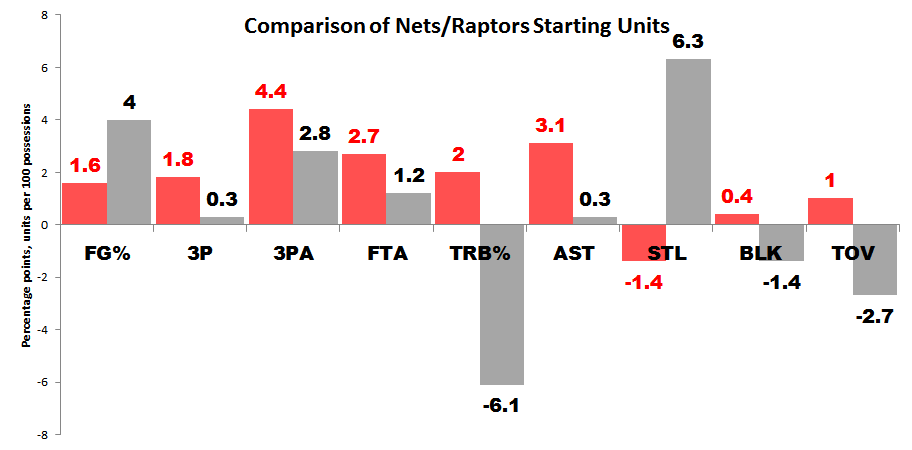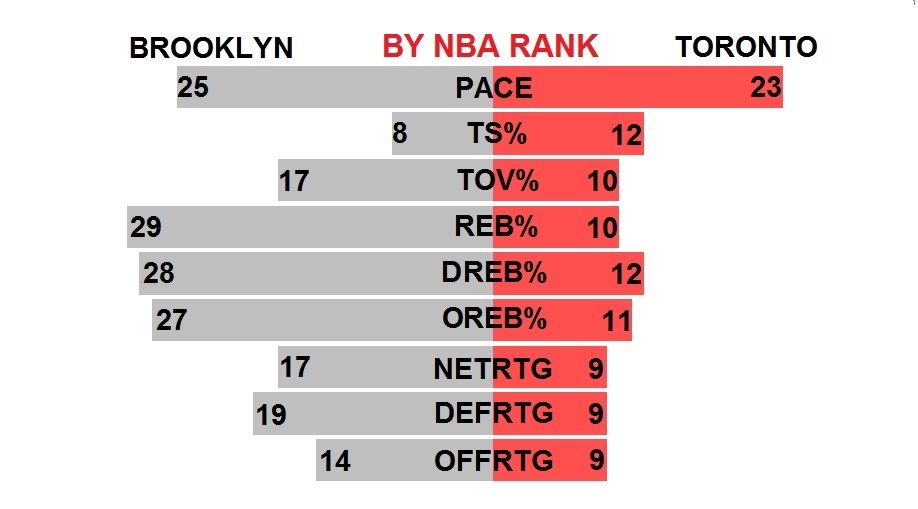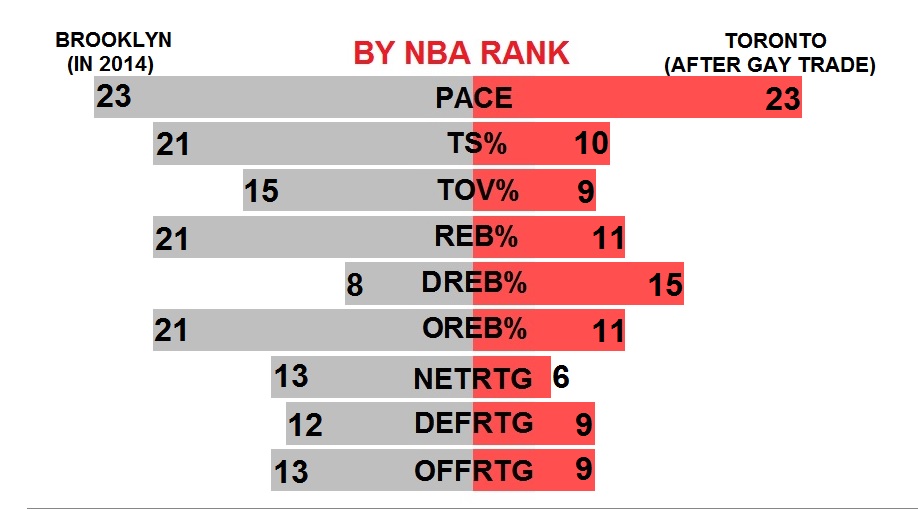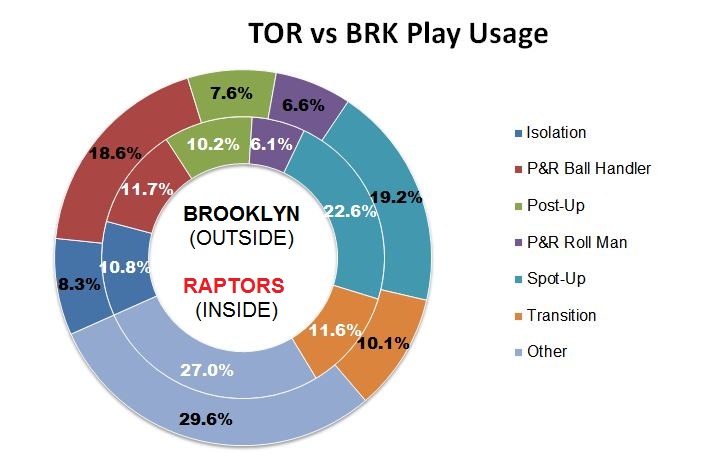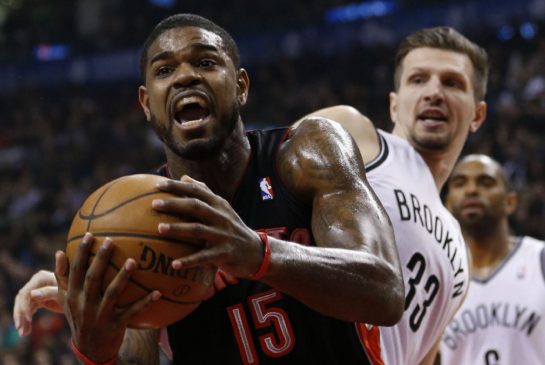Numbers never lie, or so the saying goes.
Over the next few days, we here at Raptors Republic will bombard your eyeballs with a plethora of series previews. This edition will analyze the match-up through an empirical perspective. That means this will be the only preview that won’t feature the phrase “veteran playoff experience”, except when mentioned in jest. Your convenient narratives will be discarded, doused in kerosene, and lit ablaze like a hibachi. No intangibles will be considered — it’s only numbers from herein.
—
Much like the Toronto Raptors, the Brooklyn Nets’ aggregate numbers can’t be taken at face-value because their season encompasses two different teams. As everyone here understands, the Raptors are a different team since the Rudy Gay trade. Similarly, the Nets have been a different team since the turn of the calendar.
Despite great fanfare, the Nets sputtered to start the season. A slew of injuries, and a consistent bout of coaching turmoil ultimately culminated in a 10-21 start to the season in 2013. Flip the calendar to 2014, and the Nets have suddenly flourished. Aside from their recent two-game mini-tank job, the Nets won 35 games against 15 losses in 2014.
The change was simple, if not unexpected. When All-Star center Brook Lopez went down with a broken right foot, the Nets were forced to scrap their previous game-plan, and adopt a whole new identity as a small-ball team. Only, it’s not small-ball; it’s long-ball, as Devin Kharpetian of The Brooklyn Game so aptly described. If you were to read any scouting report on the Nets, make sure it’s Devin’s.
Paul Pierce’s seamless transition into the starting power forward slot has changed the Nets’ landscape entirely. Pierce has the bulk to match-up with power forwards, and has the rebounding ability to reasonably control the defensive glass. However, Pierce at the four presents the biggest threat on offense. On a smaller scale, Pierce is like Carmelo Anthony. He’s too big to be guarded by most threes — Ross is giving up nearly 40 pounds — and he’s too quick for most fours, even at the ripe old age of 36.
The success of the long-ball strategy is reflected in the lineup data. The five-man unit of Joe Johnson, Shaun Livingston, Paul Pierce, Mason Plumlee and Deron Williams are a +4.8 points per 100 possessions in 284 minutes played this season. Switch Garnett in for Plumlee, and it bumps up to +17.8. Granted,given the Nets’ injuries this season, no unit has logged enough minutes which limits the ability to draw any solid conclusions, but one thing is clear — their long-ball lineup is dangerous.
Conversely, the Raptors’ starting five have logged a total of 716 minutes, which ranks 6th in the NBA for most minutes played this season, and posted a respectable +3.2 points per 100 possessions. The added minutes played, in theory, gives Toronto’s unit the advantage in experience and cohesion.
For the most part, Dwane Casey is a creature of habit when it comes to his lineups, which is a kind way of saying he’s stubborn and loyal to a fault. It’s likely that the two starting units — save for the inevitable swap of Salmons for Ross — will battle head-to-head for the majority of the minutes. A head-t0-head statistical profile is listed below. All numbers are expressed in terms of units per 100 possessions relative to league average. The exception is FG%, which is measured in percentage points.
The mismatches are immediately obvious. The Raptors should have a significant advantage over the Nets in rebounding, which makes sense given the Nets’ small-ball lineups. Similarly, the Raptors run a more pass-heavy offense, as evidenced by their edge in assists. However, the Nets will likely compensate by winning the battle for possessions, as they cause more turnovers (via steals), and feature four steady ball-handlers on the court, thereby limiting their own turnovers.
The difference between the two teams is also borne out in the season-long aggregate numbers. As outlined in the lineup data comparison, the Raptors hold should dominate on the glass. The plotted points are NBA rank in which smaller is better.
And before you ask, the post-Gay numbers for the Raptors, and 2014 figures for the Nets is posted below. For the most part, the same trends hold true, except the Nets’ defensive rebounding numbers have improved significantly.
Based on the eye-test, the improved rebounding is a concerted strategy by the Nets to forgo leaking out in transition in favor of securing stay misses. Similarly, the Nets also favor eschewing offensive rebounding, because aside from Mason Plumlee, the Nets’ slow and plodding bigs need a head start with back-peddling on defense.
For a deeper look, let’s dive into the synergy stats numbers. A word of precaution: the play-type categorization is somewhat questionable, because after all, what is a play? For example, say the Raptors use a pick-and-roll to set up an entry pass for Jonas in the post, who then draws a double-team, so he kicks it out to an open shooter on the perimeter. Is that a pick-and-roll, post-up, or a spot-up? According to Synergy, it’s a spot-up, which is to say the plays are categorized by result, not process.
The difference in the Nets and Raptors’ play-styles is partially illustrated in the chart above. The Nets like to run plays for Joe Johnson, Deron Williams and Paul Pierce in pick-and-roll scenarios, which is usually set up by their wing players — most notably Livingston — operating in the high post. On the other hand, the Raptors also run pick-and-rolls, but it’s usually as a means to set up spot-ups and post-ups. Lesson here? Exercise caution when extrapolating from Synergy data.
Finally, just to wrap this up, let’s lay out Vegas’ thoughts on the match-up. At the time of writing (04/17/14), the Nets are 15/1 to win the Eastern Conference, while the Raptors are 20/1. As for Game One, the Raptors are -2.0 favorites at home, with the over/under set at 194. More money (53%/47%) is being played on Brooklyn than Toronto, so it appears to be a favorable line to bet if you’re bullish on the Raptors’ chances. Or not? I don’t understand how betting works because I’m not a degenerate gambler.
Prediction: Raptors in 7. The two teams are pretty equal.
Statistical support from NBA stats, basketball-reference, 82games.com, Synergy Sports and NBA Media Central



